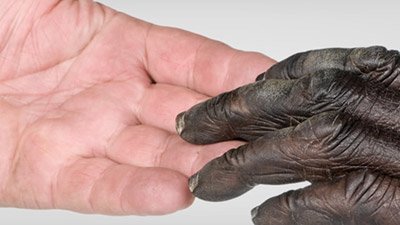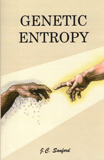A Simple Answer
Can a simple “yes or no” answer be adequate for a question about Adam and Eve’s genetic code and today’s human traits?
I have a question about Adam and Eve. If all human beings are descended from Adam and Eve, then could we expect to find the code for all human genetic traits in Adam’s and Eve’s DNA since traits are passed from generation to generation via DNA? Plaese, a simple "Yes" or "NO". As a believer,I tire of your all to frequent verbal gymnastics.
—J., U.S.
If you want a simple yes or no, then no.
Passing the Message
I [had] the privilege of hearing Mr. Carl Kerby speak at my church (First Baptist Church Seminole, Oklahoma). He was very informative and opened my eyes to a lot of very useful information. I am sorry that I didn’t get to thank him for his testimony and his sincere affection for the topics he shared with us. Please pass this along to him. I will be looking for future events in our region to attend—and share with others.
—R.R., U.S.
Have Something to Add?
Let us know what you think.
Now that’s the simple answer, and if that’s all you want, J., you don’t need to read further. However, in some ways “maybe” is a more appropriate answer. We’ve provided a complete explanation below because explaining our answer to this question isn’t as simple—some answers just aren’t! So for the logic behind that answer (we’ll try to avoid verbal gymnastics, though), please read on.
I have a question about Adam and Eve. If all human beings are descended from Adam and Eve, then could we expect to find the code for all human genetic traits in Adam’s and Eve’s DNA since traits are passed from generation to generation via DNA?
First, a quick overview: the human genetic code is what programs every cell in our body to do what it does—and thus what gives us many of the physical traits we exhibit.
In the reproductive process, a sperm cell and an egg cell each contribute 23 chromosomes (made up of DNA) to create a single zygote with 46 chromosomes; these compose the new map for the developing embryo to follow. Thus, our chromosomes originate from our parents, who got their genetic information from their parents, who got it from their parents, who got it from their parents, and so on. Likewise, we pass on our genetic information to our children, who will pass it to their children, etc.
Based on the biblical blueprint that we are all descendants of one man and one woman—Adam (see Acts 17:26 (NIV)) and Eve (see Genesis 3:20)—it would seem reasonable, then, to conclude that the genetic information in all humans today ultimately came from Adam and Eve. After all, the only other source would be if God had created humans again sometime (i.e., separately from Adam and Eve), humans whose offspring later intermarried with the offspring of Adam and Eve. But the Bible clearly teaches that this is not the case, as referenced above.1
Now, this would seem to indicate our answer to your question would be a simple yes—so why did we answer no?
The problem is that, due to the Fall, our bodies don’t always do a perfect job replicating our genetic information. Instead, there are times when mistakes—mutations, that is—creep in accidentally. Mutations can be caused by other factors, too, such as certain types of radiation. Some of these mutations occur in our somatic cells (e.g., skin cells), and thus, they are never passed along to any offspring. But if the mutation occurs in a germ cell (i.e., either a sperm or egg cell) that then fertilizes or becomes fertilized, the mutation will affect the offspring instead. This is called a germline mutation.
Mutations that result in new characteristics (traits) that weren’t present in the parent individual are thus “new” genetic traits. The traits would not have been present in Adam and Eve, but instead arose through mutations along the way; however, it’s important to note that they are not new genetic information (which I’ll explain in a moment).
Various factors influence whether the outcome of these mutations is beneficial, neutral, or harmful. Most are harmful—for example, the many forms of mental retardation that have hereditary elements; cystic fibrosis; Tay-Sachs; albinism;2 and many other traits (though we would call most “disorders”).
Some traits would be considered relatively neutral. For example, red hair is often the result of mutations (see How we got red hair (it wasn’t by evolution)); this would generally be considered neither beneficial nor harmful, though it does increase the risk of skin cancer (but much less than albinism). Likewise, while having six fingers on each hand may make it harder to find a pair of gloves that fit, it is, relatively speaking, a fairly neutral result of mutation-caused genetic abnormality.
Some mutations may have beneficial outcomes under certain circumstances (note that this is not through the addition of new information), though they also have detrimental aspects as well. For example, sickle-cell trait confers reduced susceptibility to malaria. However, those with this disorder are more likely to suffer severe problems and even death under other circumstances, such as great physical exertion, dehydration, and high altitudes, among other deleterious effects.
But whether the traits these mutations have caused are beneficial, neutral, or harmful, none of them would have been present in God’s original perfect creation.3 They are all, instead, a result of the Fall, in which Adam’s sin led to corruption in our world—and in our genetic mechanisms.
But now we get into the confusing world of semantics. We’ve explained that some genetic traits originated after the Fall, and thus those traits were not present in Adam and Eve’s DNA, instead having arisen through mutations. However, lest we confuse any readers, we’re definitely not saying that any new information has been added to the human genome, and it’s in saying this that we get into some tricky semantics. How can there be new genetic traits without new information? We’ll use a brief analogy to explain.
Let’s say I send a short “chain text message” to a friend of mine. The message is simply “Jan may have just won ten million dollars worth of Zippy Cola! Pass it on!” Trying to conserve manual exertion as my friend relays the message to his parents via computer, he types out, “Jan may have just won ten million dollars worth of Zippy Cola!” They spread the word, and as it spreads on and on, the sentence begins to change:
- “Jan may have just won ten million dollars worth of Zippy Cola!”
- “Jan may have won ten million dollars worth of Zippy Cola!”
- “Jan may have won ten million dollars wroth of cola!”
- “Jan may have won ten million dollars wroth of cola dollars wroth of cola!”
- “Jan may have won ten million dollars!”
- “Jan m ayhave won ten million dollars!”
- “Jan won ten million dollars!”
- “Jan won ten miloon dollars!”
- “Jan won ten dollars!”
Each sentence is like a different trait in that the ultimate “meaning” is different. For example, just as the original sentence conveys a very different idea than the final variation, so the genes coding for brown hair likewise cause the body to do something different than genes coding for red hair.
However, notice that no new information has been added in our sentence example; all the information present in the last variation was in the original, even though they mean different things. There’s also some meaningless junk accumulated along the way.
So was the mutation that causes cystic fibrosis in Adam and Eve? No. But the gene that ultimately became mutated (after the Fall) and now causes cystic fibrosis was present (in Adam and Eve before the Fall). So, in a way the answer to your question is both “yes” and “no.” And that’s why we would ideally answer “maybe.”
The key points to remember are that, first, we are in no way more physically human now than we were at creation; second, the human genome has devolved through mutations and time, such that there is less genetic information, not more; and third, while not all of the traits present today were present in the Garden of Eden, they originated sometime after the Curse allowed corruption to creep into our genome.
Plaese, a simple "Yes" or "NO". As a believer,I tire of your all to frequent verbal gymnastics.
As I’ve described above, the answer is definitely not a simple one. I can’t help but wonder why you specifically asked us for a simple yes or no and accused us of “verbal gymnastics.” It is true that sometimes the technical science or philosophy we write about requires a more complicated response, and we certainly apologize if you found any of our articles unclear or poorly worded, but by no means do we attempt to confuse or deceive readers. Rather, we attempt to “demolish arguments and every pretension that sets itself up against the knowledge of God, and we take captive every thought to make it obedient to Christ” (2 Corinthians 10:5).
If you do believe that any of our articles have confusing or deceptive passages, please let us know, and perhaps we can clarify or point you to a better article. A great place for anyone interested in biblical creation to start is the New Answers Book, which covers many of the most frequently asked questions we receive.
One final thought: where we succeed in communicating well in our writings, presentations, and other products, it is a credit to God and His revelation, and where we fail it is because of our own shortcomings. Perhaps we have articles that aren’t clear; certainly we have ideas that may ultimately be shown to be incorrect, although their basis, the Bible, is infallible. Yet insofar as we preach God’s Word and point people back to the Bible (and God) as the source of ultimate truth, we have no apologies.
In Christ,
Peter Galling, AiG–U.S.
Footnotes
- Of course, one could also hypothesize other wild ideas, such as the possibility of DNA from Nephilim entering the human race—see Nephilim: Who Were They? for a good analysis.
- Albinism is considered harmful because of the greater likelihood of skin cancer and related photophobia.
- This goes for animals as well. Flightless beetles, polydactyl cats, blind cave fish, and poodles wouldn’t have been around in Eden, but instead have arisen through genetic mutations (sometimes with the help of natural selection) since then.
Recommended Resources

Answers in Genesis is an apologetics ministry, dedicated to helping Christians defend their faith and proclaim the good news of Jesus Christ.
- Customer Service 800.778.3390
- © 2024 Answers in Genesis




